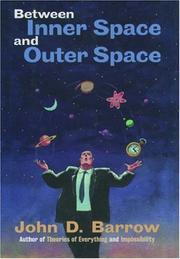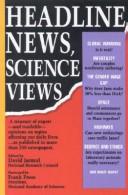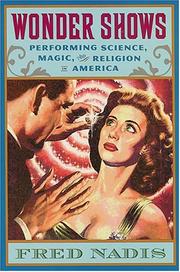| Listing 1 - 10 of 29 | << page >> |
Sort by
|
Book
ISBN: 1134187297 1281706272 9786611706272 0203942310 Year: 2007 Publisher: New York : Routledge,
Abstract | Keywords | Export | Availability | Bookmark
 Loading...
Loading...Choose an application
- Reference Manager
- EndNote
- RefWorks (Direct export to RefWorks)
Analyzing the role of journalists in science communication, this book presents a perspective on how this is going to evolve in the twenty-first century. The book takes three distinct perspectives on this interesting subject. Firstly, science journalists reflect on their 'operating rules' (science news values and news making routines). Secondly, a brief history of science journalism puts things into context, characterising the changing output of science writing in newspapers over time. Finally, the book invites several international journalists or communication scholars to comm
Journalism, Scientific. --- Science news. --- Science journalism.
Book
ISBN: 0674242629 0674242610 9780674242623 9780674242616 9780674979673 0674979672 Year: 2019 Publisher: Cambridge, MA
Abstract | Keywords | Export | Availability | Bookmark
 Loading...
Loading...Choose an application
- Reference Manager
- EndNote
- RefWorks (Direct export to RefWorks)
Fritz Zwicky was one of the most inventive and iconoclastic scientists of the twentieth century. Among other accomplishments, he was the first to infer the existence of dark matter. He also clashed with better-known peers and became a pariah in the scientific community. John Johnson, Jr.,'s biography brings this tempestuous maverick alive.
Astrophysics --- Science news. --- History --- Zwicky, F.
Book
ISBN: 0773587489 Year: 2012 Publisher: Montreal ; Ithaca : McGill-Queen's University Press,
Abstract | Keywords | Export | Availability | Bookmark
 Loading...
Loading...Choose an application
- Reference Manager
- EndNote
- RefWorks (Direct export to RefWorks)
Examining the nature of myth-making and its surprising appearance in popular science writing.
Mythology. --- Religion and science. --- Science news --- Philosophy. --- Social aspects.
Book
ISBN: 2759822478 Year: 2018 Publisher: Les Ulis Cedex A, France : EDP Sciences,
Abstract | Keywords | Export | Availability | Bookmark
 Loading...
Loading...Choose an application
- Reference Manager
- EndNote
- RefWorks (Direct export to RefWorks)
De Fontenelle à Gaston Tissandier, la Vulgarisation trace son chemin, à travers les remous de l’Histoire, avec les abbés Nollet, Pluche et Moigno – soucieux de concilier religion et science – et les républicains Arago, Figuier, Flammarion, Meunier, Jules Verne et tant d’autres. Elle permet à un public de plus en plus varié, grâce aux progrès de la presse et de l’imprimerie, de suivre de près les découvertes scientifiques, mais aussi de comprendre les progrès techniques qui modifient la vie "idienne : le chemin de fer, l’électricité, les ascenseurs, la bicyclette et l’automobile, etc. Ce public peut même assister aux démonstrations, lors des grandes Expositions universelles qui éclairent le siècle. Des collections spécialisées voient le jour, Manuels Roret, Bibliothèque des Merveilles. Les premières revues périodiques de vulgarisation se multiplient. Cosmos et La Nature préfigurent les revues modernes. De grandes revues généralistes, la Revue des Deux Mondes, Le Magasin pittoresque, l’Illustration n’hésitent pas à publier des articles de vulgarisation.
Science --- Science news. --- News, Science --- Popularization of science --- Communication in science --- Journalism --- Technical writing --- History. --- Popularization
Book
ISSN: 19673566 ISBN: 9782271072412 2271072417 2271121949 Year: 2011 Publisher: Paris : CNRS,
Abstract | Keywords | Export | Availability | Bookmark
 Loading...
Loading...Choose an application
- Reference Manager
- EndNote
- RefWorks (Direct export to RefWorks)
L'ouvrage s'intéresse à la diffusion de l'information scientifique par les médias ainsi qu'à la réception de cette information par le public.
Communication in science --- Science news --- Information scientifique --- Sciences --- Vulgarisation --- Science --- Mass media --- Study and teaching --- Influence --- Science - Study and teaching --- Mass media - Influence --- Aspect social --- Science in mass media. --- Science news. --- médias --- santé --- environnement --- communication --- télévision

ISBN: 0191583162 0585129401 9780191583162 9780585129402 0198502540 9780198502548 Year: 1999 Publisher: New York Oxford University Press
Abstract | Keywords | Export | Availability | Bookmark
 Loading...
Loading...Choose an application
- Reference Manager
- EndNote
- RefWorks (Direct export to RefWorks)
Science --- Cosmology --- Science news --- Physical Sciences & Mathematics --- Sciences - General --- News, Science --- Popularization of science --- Communication in science --- Journalism --- Technical writing --- Natural science --- Natural sciences --- Science of science --- Sciences --- Philosophy --- Popularization --- Science news.

ISBN: 0309043840 0309044804 9786610211906 1280211903 0309582970 0585155321 9780585155326 9780309044806 9781280211904 6610211906 9780309582971 9780309043847 Year: 1991 Publisher: Washington, D.C. National Academy Press
Abstract | Keywords | Export | Availability | Bookmark
 Loading...
Loading...Choose an application
- Reference Manager
- EndNote
- RefWorks (Direct export to RefWorks)
Science news --- Science --- Technology --- Health --- Medical policy --- Physical Sciences & Mathematics --- Sciences - General --- Social aspects --- Public health --- News, Science --- Popularization of science --- Popularization --- Communication in science --- Journalism --- Technical writing
Book
ISBN: 9782759811601 9782759816958 2759816958 2759811603 Year: 2014 Publisher: Les Ulis EDP sciences
Abstract | Keywords | Export | Availability | Bookmark
 Loading...
Loading...Choose an application
- Reference Manager
- EndNote
- RefWorks (Direct export to RefWorks)
Guide pratique répondant aux questions des scientifiques souhaitant vulgariser leurs savoirs avec le plus grand nombre.
Science. --- Natural science --- Natural sciences --- Science of science --- Sciences --- Science news --- News, Science --- Popularization of science --- Science --- Communication in science --- Journalism --- Technical writing --- Popularization

ISBN: 0813541212 9780813541211 081353898X 9780813538983 0813535158 9780813535159 Year: 2005 Publisher: New Brunswick, NJ
Abstract | Keywords | Export | Availability | Bookmark
 Loading...
Loading...Choose an application
- Reference Manager
- EndNote
- RefWorks (Direct export to RefWorks)
Imagine a stage full of black cats emitting electrical sparks, a man catching bullets with his teeth, or an evangelist jumping on a transformer to shoot bolts of lightning through his fingertips. These and other wild schemes were part of the repertoire of showmen who traveled from city to city, making presentations that blended science with myth and magic. In Wonder Shows, Fred Nadis offers a colorful history of these traveling magicians, inventors, popular science lecturers, and other presenters of “miracle science” who revealed science and technology to the public in awe-inspiring fashion. The book provides an innovative synthesis of the history of performance with a wider study of culture, science, and religion from the antebellum period to the present. It features a lively cast of characters, including electrical “wizards” Nikola Tesla and Thomas Alva Edison, vaudeville performers such as Harry Houdini, mind readers, UFO cultists, and practitioners of New Age science. All of these performers developed strategies for invoking cultural authority to back their visions of science and progress. The pseudo-science in their wonder shows helped promote a romantic worldview that called into question the absolute authority of scientific materialism while reaffirming the importance of human spirituality. Nadis argues that the sensation that these entertainers provided became an antidote to the alienation and dehumanization that accompanied the rise of modern America. Although most recent defenders of science are prone to reject wonder, considering it an ally of ignorance and superstition, Wonder Shows demonstrates that the public’s passion for magic and meaning is still very much alive. Today, sales continue to be made and allegiances won based on illusions that products are unique, singular, and at best, miraculous. Nadis establishes that contemporary showmen, corporate publicists, advertisers, and popular science lecturers are not that unlike the magicians and mesmerists of years ago.
Science news --- Magic shows --- Revivals --- Protracted meetings (Revivals) --- Revival (Religion) --- Evangelistic work --- Amusements --- News, Science --- Popularization of science --- Science --- Communication in science --- Journalism --- Technical writing --- History --- Popularization
Book
ISBN: 9004365974 9004365966 Year: 2018 Publisher: [S.l.] : BRILL,
Abstract | Keywords | Export | Availability | Bookmark
 Loading...
Loading...Choose an application
- Reference Manager
- EndNote
- RefWorks (Direct export to RefWorks)
In Presented Discourse in Popular Science , Olga A. Pilkington explores the forms and functions of the voices of scientists in books written for non-professionals. This study confirms the importance of considering presentation of discourse outside of literary fiction: popular science uses presented discourse in ways uncommon for fiction yet not conventional for non-fiction either. This analysis is an acknowledgement of the social consequences of popularization. Discourse presentation of scientists reconstructs the world of the scientific community as a human space but also projects back into it an image of the scientist the public wants to see. At the same time, Pilkington’s findings strengthen the view of popularization that rejects the notion of a strict divide between professional and popular science.
Science news. --- Scientists. --- Science. --- Natural science --- Natural sciences --- Science of science --- Sciences --- Professional employees --- News, Science --- Popularization of science --- Science --- Communication in science --- Journalism --- Technical writing --- Popularization
| Listing 1 - 10 of 29 | << page >> |
Sort by
|

 Search
Search Feedback
Feedback About UniCat
About UniCat  Help
Help News
News